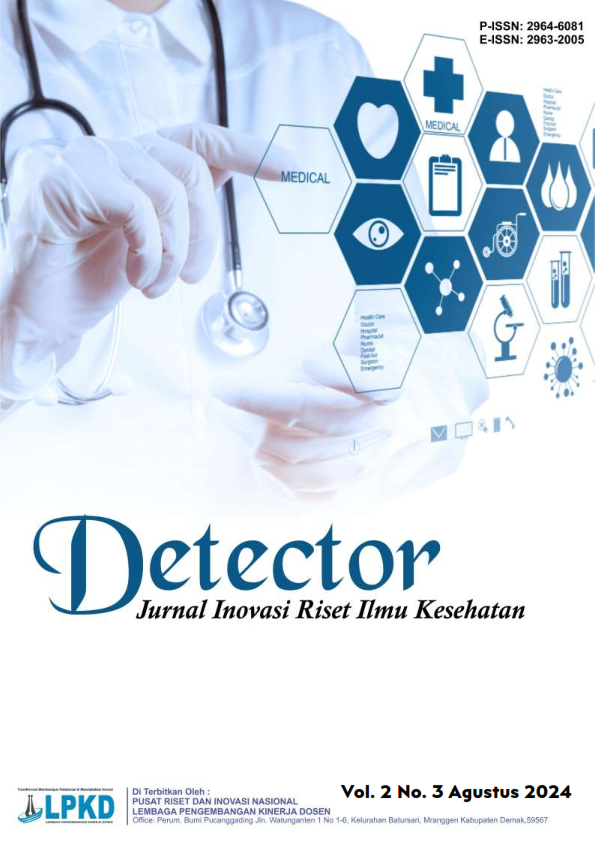Efektivitas Pemberian Jus Bayam Merah dan Pisang Ambon terhadap Kadar Hemoglobin Ibu Hamil
DOI:
https://doi.org/10.55606/detector.v2i3.4184Keywords:
Ambon Banana, Red Spinach Juice, Pregnant Women, Hemoglobin LevelsAbstract
Pregnancy is a unique natural condition because although it is not a disease, it often causes complications due to various anatomical and physiological changes in the mother's body. Pregnant women who suffer from anemia can have an impact on the fetus, such as premature birth, the risk of low birth weight (LBW), fetal abnormalities, and increased risk of fetal distress. In general, the causes of anemia in pregnancy are iron deficiency and acute bleeding or even the interaction of both. The purpose of this study was to determine the difference in the effectiveness of giving red spinach juice and Ambon bananas on Hb levels in pregnant women in the third trimester. The design used in this study was a quantitative inferential study including the pre-experimental type with two group pretest-posttest. Based on the time of data collection, it included the cross-sectional type, sourced from primary and secondary data. An assessment of the difference in increasing HB levels was carried out before and after treatment (Pretest and Postest two Group Design). Data analysis consisted of univariate and bivariate analysis. The results of the analysis showed an effect in giving red spinach juice and Ambon bananas. It is hoped that the Health Center will facilitate health workers (midwives) in providing information on providing guava juice with red spinach leaf juice as an alternative for preventing and managing anemia during pregnancy in the Health Center's work area.
Downloads
References
Delima, A. A., Asad, S., Hadju, V., & Bukhari, A. (2022, September). Effectiveness of moringa honey on hemoglobin level in pregnant women with anemia. In Proceedings of the 1st Alauddin Health and Medical International Conference.
Georgieff, M. K., Krebs, N. F., & Cusick, S. E. (2019). The benefits and risks of iron supplementation in pregnancy and childhood. Annual Review of Nutrition, 39(1), 121-146. https://doi.org/10.1146/annurev-nutr-082018-124549
Miller, J. L. (2013). Iron deficiency anemia: A common and curable disease. Cold Spring Harbor Perspectives in Medicine, 3(7), a011866. https://doi.org/10.1101/cshperspect.a011866
Moore, L. E., & Pereira, N. (2013). Physiological changes of pregnancy. In Maternal Critical Care: A Multidisciplinary Approach (p. 107).
Mizawati, A., & Maigoda, T. C. (2023). The effect of red spinach juice + Fe tablets on increased hemoglobin levels in pregnant women. Jurnal Penelitian Pendidikan IPA, 9(12), 11325-11332. https://doi.org/10.29303/jppipa.v9i12.11325
Muliawati, E., Carolin, B. T., & Lail, N. H. (2022). Comparison between the provision of white Ambon banana fruit and red dragon fruit on hemoglobin levels. Journal Name, Volume(Issue), Page numbers.
Ngandango, V. P. (2018). Etiology and risk factors associated with iron deficiency anaemia among pregnant women: A case study of Kilosa district, Tanzania (Doctoral dissertation, Sokoine University of Agriculture).
Siti Saadah Mardiah, S. M., Gina Andreyna, G. A., & Wawan Rismawan, W. R. (2021). The effect of consumption of red spinach juice on hemoglobin levels in pregnant women. Journal of Drug Delivery and Therapeutics, 11(1). https://doi.org/10.22270/jddt.v11i1.4515
Ummah, F. (2017, July). Consumption of Fe-folate with banana to the hemoglobin levels and side effects on pregnant women. In Proceedings of the Surabaya International Health Conference 2017 (Vol. 1, No. 1).
Downloads
Published
How to Cite
Issue
Section
License
Copyright (c) 2024 Detector: Jurnal Inovasi Riset Ilmu Kesehatan

This work is licensed under a Creative Commons Attribution-ShareAlike 4.0 International License.








